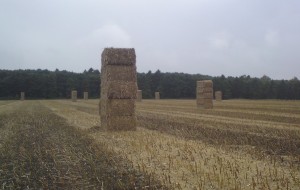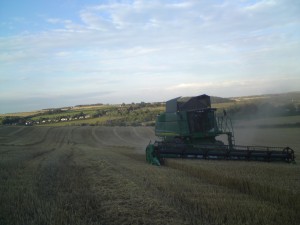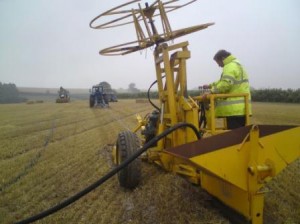 After many years of relying on long lengths of water pipe draped along fences and hedges, we finally bit the bullet and got some men in to do the job properly. Livestock need a constant supply of drinking water, and there are a few places on the farm where the supply is s bit antiquated. The safest way to supply the water is via underground plastic pipe, buried deep enough to avoid frost and damage by machinery working the soil. The machine used for the job this time is a mole plough, pulled by a winch on a tractor. The plough has a long point which pulls itself into the ground, usually between two and three feet deep, and as it travels through the soil, it feeds the water pipe, in this case inside a plastic duct, to protect against cuts from flints, down to the bottom of the trench it has made, the soil then falls back into place after the machine has passed, and simply needs rolling back down tight with a tractor wheel to level the ground. After a bit of messing about at each end, connecting up the supply, and a water trough, the job is done, hopefully reliable for years to come. It is a lot quicker and easier moling in a pipe than digging out a trench with a digger, and then filling it in again.
After many years of relying on long lengths of water pipe draped along fences and hedges, we finally bit the bullet and got some men in to do the job properly. Livestock need a constant supply of drinking water, and there are a few places on the farm where the supply is s bit antiquated. The safest way to supply the water is via underground plastic pipe, buried deep enough to avoid frost and damage by machinery working the soil. The machine used for the job this time is a mole plough, pulled by a winch on a tractor. The plough has a long point which pulls itself into the ground, usually between two and three feet deep, and as it travels through the soil, it feeds the water pipe, in this case inside a plastic duct, to protect against cuts from flints, down to the bottom of the trench it has made, the soil then falls back into place after the machine has passed, and simply needs rolling back down tight with a tractor wheel to level the ground. After a bit of messing about at each end, connecting up the supply, and a water trough, the job is done, hopefully reliable for years to come. It is a lot quicker and easier moling in a pipe than digging out a trench with a digger, and then filling it in again.
Harvest is progressing slowly, between the wet days. We are well into the wheat now, but still have well over 400 acres to cut. Much has been at 19-20% in moisture, which takes a long time to dry down to the required 14.5%. The poppies were cut yesterday, producing a pretty miserly heap at the end of it; the dry spring did them no favours at all. The picture here shows the combine working in Wynchard, with the houses in Stourpaine in the background. Mark Farwell’s combine is working in the field above the houses, but is a bit difficult to see in a picture this size!
 On one of the few good sunny days lately we managed to cut over 100 acres of wheat, yielding close to 400 tonnes, and caught up with our straw baling, including 100 small bales, as shown in the picture, we don’t make many bales of this size any more, they are too much like hard work!. This baler is getting towards 30 years old, rather like the nearly vintage tractor pulling it, they are well matched. We had two tractors like this when they were the latest thing in modern farm machinery, now long gone, and replaced over the years with the latest thing. However this one we only bought last year as it is very convenient for small and fiddly jobs like mowing, and baling, although it is a bit noisy as the cab is not soundproofed. The sledge is still a masterpiece of simple engineering, with a series of spring loaded gates, it sorts the bales into ‘flat eights’, which can then be easily picked up by a flat 8 grab on the forklift, and lifted onto a trailer.
On one of the few good sunny days lately we managed to cut over 100 acres of wheat, yielding close to 400 tonnes, and caught up with our straw baling, including 100 small bales, as shown in the picture, we don’t make many bales of this size any more, they are too much like hard work!. This baler is getting towards 30 years old, rather like the nearly vintage tractor pulling it, they are well matched. We had two tractors like this when they were the latest thing in modern farm machinery, now long gone, and replaced over the years with the latest thing. However this one we only bought last year as it is very convenient for small and fiddly jobs like mowing, and baling, although it is a bit noisy as the cab is not soundproofed. The sledge is still a masterpiece of simple engineering, with a series of spring loaded gates, it sorts the bales into ‘flat eights’, which can then be easily picked up by a flat 8 grab on the forklift, and lifted onto a trailer.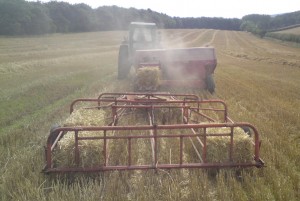
In contrast the slightly more modern round baler simply rolls up the straw into a neat cylinder, and wraps it in net, which is slightly waterproof. These are very easy to use in the winter, either for bedding animals, when you can simply roll them undone, or you can put them in a round feeder, giving maximum access for the animals to feed.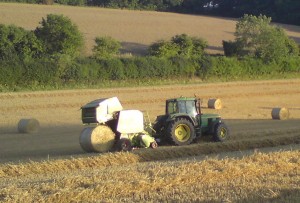
Most of the contractors who buy our straw nowadays use big bales, which cram a lot of straw into a very dense package, which is most cost effective for transport. The big balers have an enormous appetite, and can wrap up a huge amount of straw in a day, and a good operator can clear a field and stack a lot of bales in a very short time.